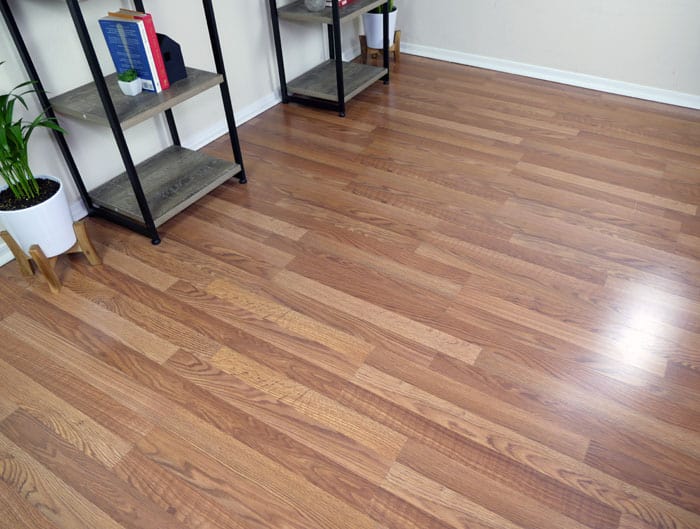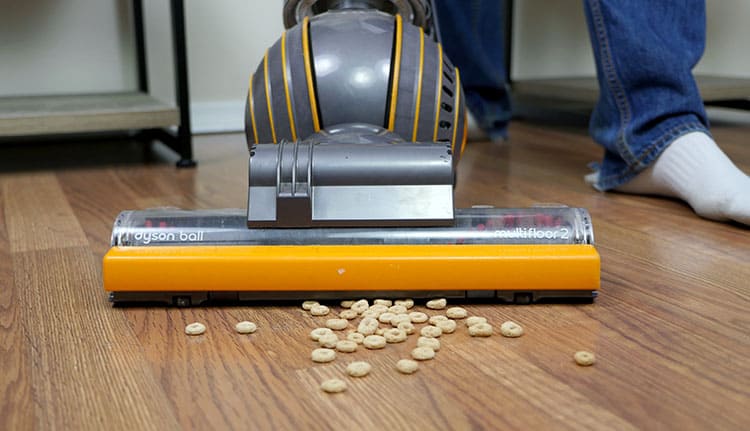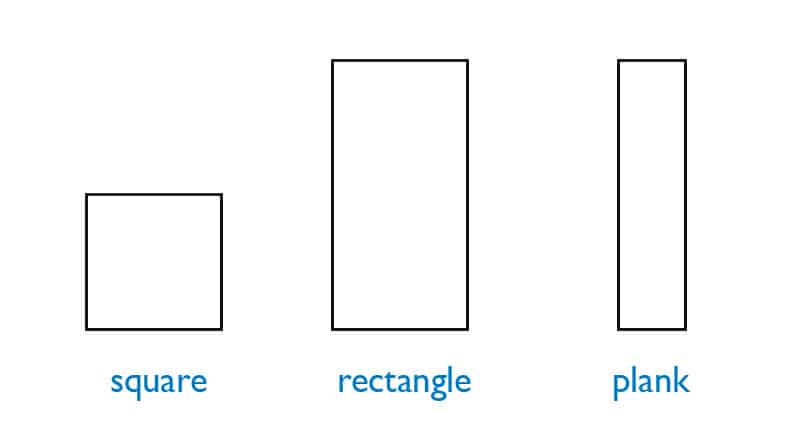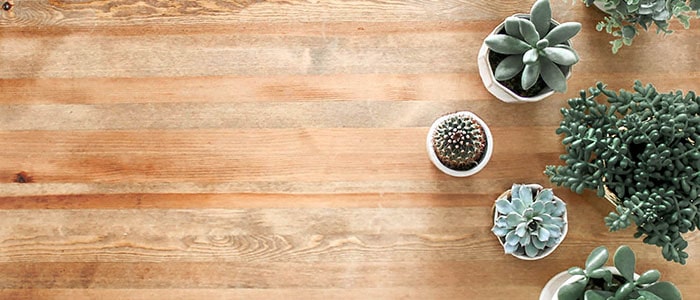If the cost of traditional hardwood floors is hard to stomach, then the alternative may be more in your price range. Wood-look tile is just that — tile that has the look of wood without the higher cost.

To decide which flooring material is right for you, this guide breaks down and compares hardwood vs. wood look tile.
| Feature | Hardwood | Wood-Look Tile |
|---|---|---|
| Materials | Real Wood | Ceramic or Porcelain |
| Durability | Good | Great |
| Care & Maintenance | Moderate | Easy |
| Approved Locations | Dry | Dry + Damp |
| Cost | $6-22 / installed | $9-40 / installed |
| Sizes | Plank, Tile, Strips | Tile |
| Install | Pro | Pro or DIY |
| Moisture | Prone to Moisture | Water-resistant |
| Pets | Prone to Scratches | Pet-friendly |
| Sound Absorption | Good | Poor |
| Eco-Friendly | Average | Poor |
| Find a Local Installer | Find a Pro | Find a Pro |
Table of Contents
- Appearance
- Durability
- Care & Maintenance
- Application
- Cost
- Sizes
- Install
- Moisture
- Pets
- Sound
- Eco-Friendly
- Which is right for you?
What is it made of?
Hardwood
Wood
Wood-Look Tile
Clay, Sand & Water
What’s hardwood made from?
True hardwood flooring is made of just that — hardwood. Trees are cut down and milled to form the shape of the planks. Depending on how the wood is cut and what species of wood is used, there will be various grain patterns.

Some of the most popular species of woods for hardwood flooring include:
- Ash
- Basswood
- Beech
- Cherry
- Elm
- Hickory
- Birch
- Mahogany
- Sweetgum
- Maple
- Oak
- Walnut
What’s wood look tile made from?
Wood-like tile comes in either porcelain or ceramic. Both types are a combination of clay, sand, and water. The tiles are formed and then baked in a kiln at high temperatures. The type of clay and sand used to produce the tiles can vary by manufacturer.
Tiles can also come unglazed or with a glazed coating. They can also be polished by cutting into the surface after firing, providing a shiny finish without glazing. Porcelain tiles can also come digitally printed with virtually any pattern.
1. Appearance
Hardwood flooring is made with one goal in mind: to look like hardwood. This look has appealed to homeowners for centuries.
While most prefer the natural wood look, hardwood flooring can be stained virtually any color to please different aesthetics. This is typically called finished hardwood.

There are also different grades to hardwood flooring that you can purchase:
- Select: Minor imperfections and tone variations. This is the most expensive option available.
- #1 Common: May include some small knots and holes with small imperfections. Coloration and tone variations are more noticeable.
- #2 Common: Larger knots and holes with greater variations in color and tone.
- Tavern: Knots, holes, and noticeable tone variations. It can also include broken and uneven edges along with machine burns from the milling process.
Wood-like tile comes in porcelain or ceramic and different finishes:
- Unglazed
- Glazed
- Digitally printed
If a specific wood is too expensive, digitally printed wood-look tile could be a more cost-effective option.
2. Durability
Hardwood
Good
Wood-Look Tile
Great
When comparing the durability of hardwood vs. wood look tile, tile can generally stand up to more abuse.
Hardwood flooring’s ability to last depends on the type of wood used and the finish. Install is also an important aspect. Poor install or an improper substrate can lead to cracking, bowing, or warping of the planks.

Prefinished wood is sealed in the factory to provide layers of protection prior to being sent to the manufacturer. Unfinished hardwood requires a sealant to be applied once the flooring is installed.
PRO TIP: Want the look and feel of hardwoods with improved durability? Check out engineered hardwoods, which are man-made products that pile up assemblies of real wood to provide a 100% hardwood product, with greater durability over time.
Sealing options available:
- Water-based polyurethane
- Oil finish
- Wax finish
- Aluminum oxide
Regardless of the sealant, finish, and wood hardness, hardwood flooring can dent and show wear. Pet nails, moisture, and even dirt can create imperfections in wood flooring without proper care.
Wood-look tile, on the other hand, is more durable and resistant to scratches, dents, and everyday wear. Tile is moisture-resistant and can bear more weight and household traffic than hardwood. Chips and cracks can happen over time or if heavy items are dropped.
3. Care and Maintenance
Hardwood
Moderate
Wood-Look Tile
Easy
Caring for hardwood and wood-look tile floors takes a little bit of effort to keep them looking new.
How to clean hardwood and wood-look tile?
Cleaning hardwood floors can be done in a couple different ways.
- Dry sweeping: Consider a microfiber mop
- Mopping : Check out our line up for the best mops.
- Vacuum: Consider the out the Dyson Multi-floor Ball upright vacuum
- Damp mopping: Check out the Roomba Braava m6 robot mop

How to repair hardwood and wood-look tile?
For most scuffs and dents, hardwood can be repaired. Different methods can be used depending on severity:
- Wood filler and restaining
- Replacing damaged planks
- Using water to raise up dents
- Sanding and refinishing
Wood-look tiles can also be repaired or replaced. There are kits you can get online for repairs. If you can match the tile, the existing damaged tile(s) can be removed and replaced.
Do you need to seal hardwood or wood-look tile?
For the most durability and longevity, yes. This is where the higher maintenance comes in, especially for hardwood.
To provide the most protection, hardwood floors should be sealed every few years. Depending on the hardness of the wood flooring, sanding and refinishing will be needed at some point to bring new life to the floor surface.
Wood-look tiles don’t have to be sealed, but it can protect the grout from discoloring and tiles from chipping or cracking.
4. Cost
Hardwood
$6-22/sf installed
Wood-Look Tile
$9-40/sf installed
The cost of hardwood vs. porcelain or ceramic tile could be substantial depending on the material used. Porcelain is more expensive than ceramic tile, but it’s also denser and more water-repellent than ceramic.
Higher-end wood can cost much more per square foot compared to wood-look tile. Hardwood is also more complicated and time-consuming to install than tile, so the installation cost can be twice that of tile.
5. Application
Wood-look tile is more suitable for wet spaces like kitchens and bathrooms vs. hardwood. In the living room, hardwood floors may be a better option vs. tile flooring. However, tile stands up better to everyday traffic over hardwood.

What rooms are hardwood and wood-look tile best for?
| Location / Room Type | Hardwood | Wood-Look Tile |
|---|---|---|
| Kitchen | Maybe | Yes |
| Bathroom | No | Yes |
| Laundry | Maybe | Yes |
| Entry | Yes | Yes |
| Common Room | Yes | Yes |
| Gym | Maybe | Maybe |
Be cautious installing hardwood floors near water. Wood-look tile is cold and hard, more so than hardwood flooring.
Consider these factors when deciding which room to put each flooring material. Mixing hardwood with wood-look tile could be an alternative approach.
RELATED – Want more flooring choices? Check out other options available for the home.
6. Sizes
Hardwood
Varies
Wood-Look Tile
Varies
Hardwood flooring most often comes in planks, but can also come in tile and smaller strips. Wood-look tile comes in square or rectangle shapes. Sizes can vary, but most common include:
- Tile: square (12×12″ or 24×24″) or rectangle (12×18″ or 18×36″)
- Plank: narrower and longer than tile (6×36″)

7. Install
Hardwood
Pro
Wood-Look Tile
Pro or DIY
While installing the flooring yourself can save money on the project, some flooring types should be left to a professional. Expansion and contraction spacing, along with blending color variations are just some of the reasons hardwood flooring installation is best left to a professional.

Wood-look tile may be done yourself, but proceed with caution. Subflooring must be laid precisely and specific spacing is needed for the grout. Also, blending the pattern for aesthetics is sometimes harder than it looks.
PRO TIP: If you’re installing wood look tile yourself, consider a “1/3rd offset” between each tile. This offset helps to hide imperfections and cupping that can sometimes occur between times.
For either of these materials, it could be worth it to pay the extra cost for professional installation if you are unsure about the process or simply don’t have the time to dedicate to the job.
PRO INSTALL: Get a quote for an installer in your area today.
8. Moisture
Hardwood
Prone to Moisture
Wood-Look Tile
Water-Resistant
Moisture is an enemy to hardwood floors, causing warping and discoloration if not properly sealed. In areas of high humidity and water-prone rooms like kitchens and bathrooms, wood-look tile is a better option.
In its perfect state, wood-look tile is 100% waterproof, but cracks in the tile or grout can provide entry points for moisture or humidity to get into the tile and cause cracking or other damage.

A moisture barrier installed under the flooring (of hardwoods or wood-look tile) is a great way to protect from water damage beneath the floor layer.
9. Pets
Hardwood
Prone to Scratches
Wood-Look Tile
Pet-Friendly
Wood-look tile is generally a better option for pet owners than hardwood flooring. Some hardwood will pit or dent much easier than other wood, while the tile is more pet-friendly.

- Scratches: Damage from pet nails is almost impossible on wood-look tile. The heavier the pet, the greater the chance of damage can be in hardwood floors. Sealing hardwood floors can help to hide scratches. When selecting a sealant, go for a matte finish over gloss, which can help reduce the appearance of scratches.
- Pet Odor: Both flooring types are resistant to odor because of the hard surface.
- Accidents: If cleaned up promptly, both wood-look tile or natural hardwoods would be resistant to small pet spills or accidents. Depending on the smoothness of the hardwood, the residue could be left behind in cracks or crevices if not cleaned up immediately.
10. Sound Absorption
Hardwood
Moderate
Wood-Look Tile
Poor
Wood-look tile flooring is one of the worst choices for sound absorption. It can actually echo sounds in an open space. While hardwoods aren’t as good as carpet or vinyl planks, they are better at soaking up sound than porcelain or ceramic tile.
RELATED: Cheapest way to sound proof a room
The applied substrate may also play a role in sound absorption. Tile or hardwoods installed over a concrete substrate will echo more than the same materials installed over a sound dampening underlayment.
Underlayments designed for sound absorption may be made of rubber, felt, or polypropylene.
CHECK PRICE: Check out these options for soundproof underlayments.
Cushioned furniture and area rugs can help absorb sound and also take the chill off either floor surface.
11. Eco-friendly
Hardwood
Average
Wood-Look Tile
Poor
Is one of these materials more “green” than the other? Neither of them is considered eco-friendly, but one is better for the environment than the other.

While it’s true that wood is a renewable resource, it’s not always sourced ethically. To ensure wood flooring is sourced in the best way possible, check for Forest Stewardship Council (FSC) Certification.
Though sourced materials are eco-friendly, kiln firing of wood-look tiles creates a larger carbon footprint compared to hardwood.
PRO TIP: For an eco-friendly wood-look flooring option, consider bamboo or cork. Bamboo is a fast-growing renewable resource and cork is made from just the bark of a cork oak tree.
Hardwood vs. Wood-look Tile: Which is right for you?
There are certainly advantages and disadvantages to both floor options.
RELATED: Need furniture ideas? Here’s our take on the best pieces for each room.
With wood-look tile, you can get a similar look to hardwood and save money. However, in most markets, wood flooring holds its value for resale better than wood-look tile.

The flooring decision comes down to a few key considerations to determine which is a better choice:
- What is the budget for the project?
- Which room is the flooring for?
- Do you live in a humid area?
- What is your family made up of (kids, pets, elderly)?
- How heavily trafficked is the room?
Answering these questions will help you decide which flooring surface is right for you.
Still Have Questions?
Are you still not sure what is the best flooring option for you? We’re here to help. Just ask your question in the comments down below. We’d be happy to give you a recommendation tailored to your space.
Ready to Get Started?
Are you ready to take the next step? There are professional installers and contractors in your area waiting to help with your next project. Click here to fill out the form and get instant quotes.
